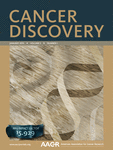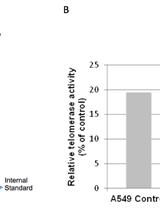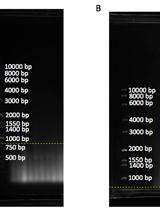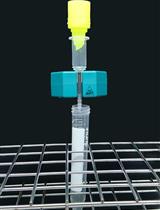- EN - English
- CN - 中文
Telomere Dysfunction Induced Foci (TIF) Analysis
端粒功能失调诱导病灶(TIF)分析
发布: 2015年11月20日第5卷第22期 DOI: 10.21769/BioProtoc.1656 浏览次数: 12949
评审: HongLok LungVanesa Olivares-IllanaAnonymous reviewer(s)
Abstract
Telomerase maintains telomeric DNA in eukaryotes during early developments, ~90% of cancer cells and some proliferative stem like cells. Telomeric repeats at the end of chromosomes are associated with the shelterin complex. This complex consists of TRF1, TRF2, Rap1, TIN2, TPP1, POT1 which protect DNA from being recognized as DNA double-stranded breaks. Critically short telomeres or impaired shelterin proteins can cause telomere dysfunction, which eventually induces DNA damage responses at the telomeres. DNA damage responses can be identified by antibodies to 53BP1, gammaH2AX, Rad17, ATM, and Mre11. DNA damage foci at uncapped telomeres are referred to as Telomere dysfunction-Induced Foci (TIFs) (de Lange, 2005; Takai et al., 2003).
The TIF assay is based on the co-localization detection of DNA damage by an antibody against DNA damage markers, such as gamma-H2AX, and telomeres using an antibody against one of the shelterin proteins such as TRF2 (Takai et al., 2003; de Lange, 2002; Karlseder et al., 1999). The method we describe here can be used in normal human and cancer cells.
Other commonly used methods-Telomere Restriction Fragment (TRF) Analysis (Mender and Shay, 2015b) and Telomere Repeat Amplification Protocol (TRAP) (Mender and Shay, 2015a)- in telomere biology can be found by clicking on the indicated links.
Materials and Reagents
- Lab-Tek II Chamber slides (Thomas Scientific, catalog number: 154461 )
- Cancer or normal human cells
- Triton X-100 (J.T. Baker Chemical Co., catalog number: 7-x198 )
Octyl Phenol Ethoxylate (Avantor Performance Materials, J.T. Baker, catalog number: X198-07 ) - Paraformaldehyde (PFA) (Sigma-Aldrich, catalog number: P6148 )
- Nonidet-P40 (Fluka BioChemika, catalog number: 74385 )
Note: Currently, it is “Sigma-Aldrich, catalog number: 74385”. - Fish gelatin blocking buffer, 10% (Amresco, catalog number: M319 )
- Bovine Serum Albumin (BSA), Fraction V (Gemini Bio-Products, catalog number: 700-106P )
- Anti-phospho-histone H2A.X (Ser139, mouse) Antibody (Merck Millipore Corporation, catalog number: 05-636 )
- Anti-TRF2 Antibody [EPR3517 (Ouellette et al., 2000)] (rabbit) (Abcam, catalog number: ab108997 )
- Donkey anti-Rabbit IgG (H+L) Secondary Antibody, Alexa Fluor® 488 conjugate (Invitrogen, catalog number: A-21206 )
Note: Currently, it is “Thermo Fisher Scientific, NovexTM, catalog number: A-21206”. - Goat anti-Mouse IgG (H+L) Secondary Antibody, Alexa Fluor® 568 conjugate (Invitrogen, catalog number: A-11004 )
Note: Currently, it is “Thermo Fisher Scientific, NovexTM, catalog number: A-11004”. - Vectashield® Mounting Medium with DAPI (Vector Laboratories, catalog number: H-1200 )
- Deltavision® Immersion Oil N=1.518 (GEHC, part no: 290291717 )
- Phosphate-buffered saline (PBS)
- MilliQ® water
- 10x PBS buffer-phosphate buffer saline (see Recipes)
- 1x PBST buffer (see Recipes)
Equipment
- Personal DeltaVision wide-field fluorescent microscope (GE Healthcare, model: PD11435 )
- Lamp (Xenon)
- Camera (Photometrics)
- 60x/1.42 N.A. (numerical aperture) objective (Olympus)
Software
- DeltaVision® SoftWoRx software (GE Healthcare)
- Autoquant® Software (Media Cybernetics)
- Imaris® Software (Bitplane Imaris)
Procedure
文章信息
版权信息
© 2015 The Authors; exclusive licensee Bio-protocol LLC.
如何引用
Mender, I. and Shay, J. W. (2015). Telomere Dysfunction Induced Foci (TIF) Analysis. Bio-protocol 5(22): e1656. DOI: 10.21769/BioProtoc.1656.
分类
癌症生物学 > 无限复制 > 细胞生物学试验 > 核酸测序
癌症生物学 > 无限复制 > 细胞生物学试验 > 蛋白质
您对这篇实验方法有问题吗?
在此处发布您的问题,我们将邀请本文作者来回答。同时,我们会将您的问题发布到Bio-protocol Exchange,以便寻求社区成员的帮助。
提问指南
+ 问题描述
写下详细的问题描述,包括所有有助于他人回答您问题的信息(例如实验过程、条件和相关图像等)。
Share
Bluesky
X
Copy link














